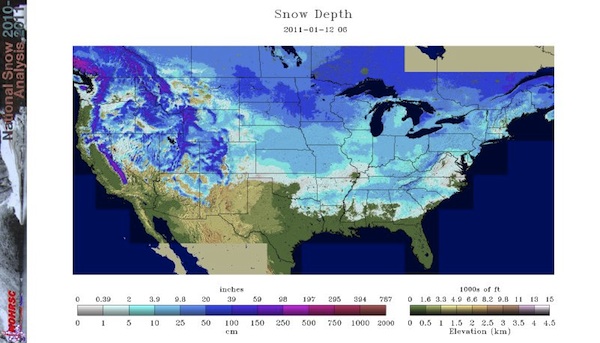
Weather Rarity: Snow in 49 States

Get out the toboggans and winter gloves: There's snow on the ground in 49 out of 50 U.S. states – including Hawaii.
The only state that isn't at least partially a winter wonderland today is Florida, according to the National Weather Service (NWS). The agency estimates that 70.9 percent of the country is currently covered by snow. [Read: What Are the Chances of a White Christmas Everywhere?]
"It's not typical," NWS public affairs officer James Peronto told LiveScience. The National Operational Hydrologic Remote Sensing Center, which tracks snowfall, doesn't keep statistics on the average snow cover, Peronto said. However, in December, an average of 35 percent of the United States had snow on the ground.
Unusual Southern Storm
Snow in the Rocky Mountain states and Northeast is the norm in winter, of course. Even Hawaii often sees snowfall at high elevations. Right now, the top of the dormant volcano Mauna Kea on the island of Hawai'i is covered with 7 inches (18 centimeters) of snow.
What's unusual about today is the winter storm that passed through the Southeast, Peronto said.
"The Southern states don't typically get significant snow amounts through the year," Peronto said. "It takes a special kind of weather scenario to allow that to happen."
Sign up for the Live Science daily newsletter now
Get the world’s most fascinating discoveries delivered straight to your inbox.
In this case, moisture from the Gulf of Mexico met up with cold air parked over the South. The result: Ice, sleet and plenty of the white stuff.
Snow in the eastern third of the United States is particularly unusual this year because La Nina (unusually cold ocean temperatures in the Pacific near the equator) normally keeps the jet stream in the northern regions of the United States, said David Robinson, the state climatologist of New Jersey and a professor at Rutgers University.
But recently, the La Nina effect has been overshadowed by a negative North Atlantic Oscillation, an atmospheric pattern that brings cold and snow to the East and Southeast.
"If the North Atlantic Oscillation was what we call neutral or positive, we might have our lounge chairs out today," Robinson told LiveScience. [Read Q&A with Robinson About Wild Winter Weather]
Snow over time
Snow in so many states is "not an every-winter event," Robinson said, though the last time it snowed in all 50 states was last February. Before that, he said, you have to go back to the 1970s to find winters where snow fell across so much of the North American continent.
"The size of the United States is such that when the jet stream dips down in the east and brings a lot of cold air and snow to make it down into Georgia and South Carolina, it bulges up in the west," Robinson said. That usually keeps snowy conditions out of places like Texas while it's also snowing in the Deep South.
On his website, Robinson tracks daily divergence from average snowfall. The map for Jan. 11 shows a large swath of above-average areas.
Robinson's research hasn't turned up any long-term changes in winter-snow cover in the United States over the last 40 years. But spring-snow cover is decreasing, he said.
"Last winter, we had a record extent of snow cover over North America, and last spring was a record low extent [of snow cover]," Robinson said. "So we went from one extreme to another."
You can follow Live Science Senior Writer Stephanie Pappas on Twitter @sipappas.

Stephanie Pappas is a contributing writer for Live Science, covering topics ranging from geoscience to archaeology to the human brain and behavior. She was previously a senior writer for Live Science but is now a freelancer based in Denver, Colorado, and regularly contributes to Scientific American and The Monitor, the monthly magazine of the American Psychological Association. Stephanie received a bachelor's degree in psychology from the University of South Carolina and a graduate certificate in science communication from the University of California, Santa Cruz.









